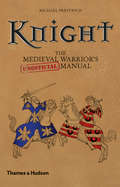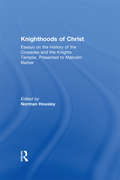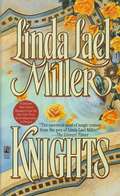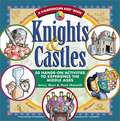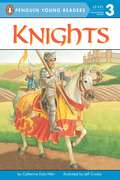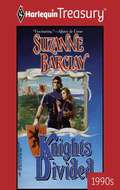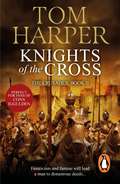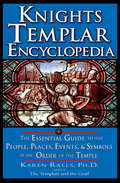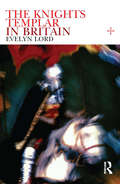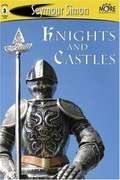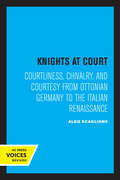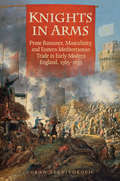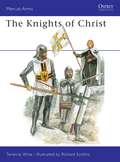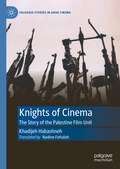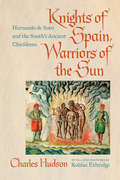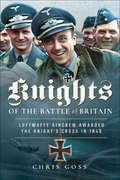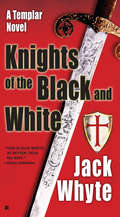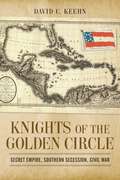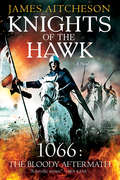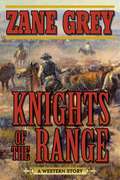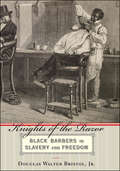- Table View
- List View
Knight: The Medieval Warrior's (Unofficial) Manual
by Michael PrestwichAn insider's guide: how to become a knight, wield a sword, join a Crusade, and make your fortune. The knight is the supreme warrior of the Middle Ages. Fully armored and mounted on a magnificent charger, he seems invincible. Honor and glory await him as, guided by the chivalric code, he fights with lance and sword. This carefully researched yet entertaining book provides all the essential information you need to become a successful knight in the later Middle Ages, during the period of the Hundred Years' War. Should you go on a Crusade? Which order of chivalry might you consider joining? What is required when you go through the ceremony of knighthood? Here are the answers to these and many more questions plus practical advice on topics such as equipment, fighting methods, and the conventions of warfare. But the knightly life is not all battles and sieges: there are also tournaments and jousts to enjoy and the world of courtly love. Based on contemporary lives and descriptions, this book--written by a leading medieval historian--paints a vivid picture of what it was like to be a medieval knight.
Knighthoods of Christ: Essays on the History of the Crusades and the Knights Templar, Presented to Malcolm Barber
by Norman HousleyDuring the Central Middle Ages Catholics had the opportunity to take part in Holy War in the Latin East in two different but related ways, by taking the Cross and by entering the Order of the Temple. Both crusaders and Knights Templar were dubbed by contemporary panegyrists milites Christi, knights engaged in combat for the cause of Christ. On numerous battlefields in the Middle East crusaders and Templars fought side by side. By the late thirteenth century both modes of Holy War faced critical situations. Crusading failed to save the mainland states of Palestine and Syria from Muslim conquest in 1291, while the Knights Templar entered a period of internal demoralisation and external attack that culminated in the suppression of their Order in 1312. This collection of essays by distinguished historians of the Crusades and the Order of the Temple covers the whole span of their historical evolution and offers numerous insights into the ideologies, practicalities and ramifications of Christian Holy War in the Middle Ages.
Knightly Memories: Remembering and Reinventing the Military Orders in Britain (ISSN)
by Elizabeth SiberryThis is the first book-length study of the legacy and memory of the main military orders in Britain, the Templars and Knights of St. John. It provides a survey from the late 18th to the early 20th centuries using hitherto neglected sources and identifies areas for further research and analysis.The volume first examines the historiography of the Orders, delving past the standard histories to examine their authors, readership, accessibility, advertisements. and reviews. It then discusses the material memory of the Orders, from the Temple Church in London and St. John’s Gate at Clerkenwell to archaeological discoveries and romanticised stained-glass depictions. Turning next to the revival and reinvention of the Order of St John after the loss of Malta in 1798 and the foundation of the British Order based at Clerkenwell, it unravels fact from fiction in the claims of continuity with the medieval knights made by the Masonic Knights Templars. For many, memory was shaped by popular fiction as well as history, so the final part considers various literary interpretations of the Orders’ history.This book will interest scholars and students of the Military Orders and Crusades, as well as general readers of the history of memory and reception.
Knights
by Linda Lael MillerIn medieval England, Gloriana, Lady of Kenbrook, awaits her husband, Dane St. Gregory, whom she has not seen since childhood. She is stunned to discover that he has returned with a betrothed; beautiful Gloriana is to be cast into a nunnery. Dane's mysterious sister-in-law, Elaina, counsels her to win Dane's heart or see the entire Kenbrook line imperiled. Entranced by her passionate will, he cannot resist Gloriana's potent charm, while she falls ever more deeply in love with Dane, her valiant swordsman. But their newfound happiness is brief -- suddenly, Gloriana is swept across the chasm of time to a dazzling future. Trapped centuries apart, Gloriana and Dane suffer the torment of their longing, knowing that only their love for one another and the strength of their desire can reunite them at last.
Knights & Castles: 50 hands-on activities to experience the Middle Ages
by Paul Mantell Avery HartIntroduces the Middle Ages, including activities and crafts that are representative of medieval life, for example, creating an hourglass, a catapult, a coat of arms, and a code of honour.
Knights (Penguin Young Readers, Level 3)
by Catherine Daly-WeirA young knight-in-training has so much to do-learn about arms and armor, assist a squire, attend a medieval banquet, tilt at the quintain-and prepare to be "dubbed!" This is a surefire, nonfiction subject for newly independent readers.
Knights Divided
by Suzanne BarclayThough Emmeline Spencer captured Jamie Harcourt as her prisoner, the rogue adventurer stole kisses from her that were sweet beyond her wildest imagining. Yet how could Emma love the man suspected of the murder of her beloved sister?Heir to the Sommerville legacy of bravery, Jamie Harcourt had willingly entered a maze of intrigue knowing full well there was little hope of escape. Though he hadn't counted on the interference-or the inspiration-of the Lady Emmeline.
Knights Of The Cross: the extraordinary story of the First Crusade - gripping from the first page
by Tom HarperPerfect for fans of Conn Iggulden, Lindsey Davis, Steven Pressfield, this breathtaking and captivating novel brings the Crusades to life in all their triumphant and tragic glory.'Gripping from the first page, the reader is swept up in this colourful and convincing portrayal of an Emperor and his realm under siege.' - Ink'Superb read. Thoroughly enjoyed it' -- ***** Reader review'Highly enjoyable read' -- ***** Reader review'Brilliant.' -- ***** Reader review'Holds your interest from [the first] to the last page' -- ***** Reader review********************************************************************AN ASSASSIN IS ON THE LOOSE...AND AN EMPIRE STANDS IN PERILByzantium, 1096: When a mysterious assassin fires his arrow at the Emperor, he has more than a man in his sights; as the keystone of a crumbling empire, if he falls, then the mightiest power in Christendom will be torn apart. Aware of the stakes, the Emperor hires Demetrios Askiates, the unveiler of mysteries, to catch the would-be-killer.But Demetrios is entering an unknown and mysterious world and must edge his way through a glittering maze of treachery and deceit before time runs out. Nor are all enemies within the city walls. With the Turks rampant across Asia, the Emperor has sent to the west for mercenaries to reinforce his position.When a great army, tens of thousands strong, appears before the gates, he gets more than he bargained for. The first crusaders have arrived, intent on making their fortunes in war, and they have no allegiance to an empire they eye with jealousy and suspicion.As the armies of east and west confront each other, and the assassin creeps ever closer to his prey, Demetrios must untangle the golden web of intrigue which surrounds the Emperor before the city - and the empire - are drowned in blood.
Knights Templar Encyclopedia: The Essential Guide to the People, Places, Events, and Symbols of the Order of the Temple
by Karen RallsThis authoritative sourcebook offers comprehensive information on Knights Templar history, symbols, key figures, unanswered questions, and more. Who were the Knights Templar? And how did they become the wealthiest multinational corporation in the medieval West? These powerful crusaders of the late Middle Ages remain a source of fascination for their mysterious ways and their far-reaching influence. The knights of the Order of the Temple were not only warriors, but also diplomats, international banking experts, advisors to popes and kings, and much more. Written by leading Templar authority and medieval historian Dr. Karen Ralls, Knights Templar Encyclopedia presents the history of the Order of the Temple in an accessible A-to-Z format. This authoritative sourcebook features a wealth of information on the key Templar people, places, events, symbols, organization, daily life, beliefs, economic empire, trial, and more. It includes photos and illustrations, an extensive bibliography, a historical timeline, and a list of major European Templar sites.
Knights Templar in Britain
by Evelyn LordThe Knights Templar In Britain examines exactly who became knights, what rituals sustained them, where the power bases were, and how their tentacles spread through the political and economic worlds of Britain before their defeat at the hands of the Inquisition some two hundred years later.Founded in the early twelfth century, the mysterious Knights Templar rose to be the most powerful military order of the Middle Ages. While their campaign in the Middle East and travels are well-known, their huge influence across the British isles remains virtually uncharted. For readers interested in Medieval History.
Knights and Castles
by Seymour SimonSeeMore Readers are designed for every young reader. Large, bright pictures instantly engage readers in the subject. Exciting yet simple text provides the information that kids, parents, and teachers wantfrom key facts to fascinating trivia. Each Reader is a fun invitation to read, observe, and see more!
Knights at Court: Courtliness, Chivalry, and Courtesy from Ottonian Germany to the Italian Renaissance
by Aldo ScaglioneKnights at Court is a grand tour and survey of manners, manhood, and court life in the Middle Ages, like no other in print. Composed on an epic canvas, this authoritative work traces the development of court culture and its various manifestations from the latter years of the Holy Roman Empire (ca. A.D. 1000) to the Italian Renaissance of the fifteenth and sixteenth centuries. Leading medievalist and Renaissance scholar Aldo Scaglione offers a sweeping sociological view of three geographic areas that reveals a surprising continuity of courtly forms and motifs: German romances; the lyrical and narrative literature of northern and southern France; Italy's chivalric poetry. Scaglione discusses a broad number of texts, from early Norman and Flemish baronial chronicles to the romances of Chrétien de Troyes, the troubadours and Minnesingers. He delves into the Niebelungenlied, Dante, Petrarch, Boccaccio, and an array of treatises on conduct down to Castiglione and his successors. All these works and Scaglione's superior scholarship attest to the enduring power over minds and hearts of a mentality that issued from a small minority of people—the courtiers and knights—in central positions of leadership and power. Knights at Court is for all scholars and students interested in "the civilizing process." This title is part of UC Press's Voices Revived program, which commemorates University of California Press’s mission to seek out and cultivate the brightest minds and give them voice, reach, and impact. Drawing on a backlist dating to 1893, Voices Revived makes high-quality, peer-reviewed scholarship accessible once again using print-on-demand technology. This title was originally published in 1991.
Knights in Arms
by Goran StanivukovicDrawing from medieval chivalric culture, the prose romance was a popular early modern genre featuring stories of courtship, combat, and travel. Flourishing at the same moment as the growing English trade with the Eastern Mediterranean, prose romances adopted both Eastern settings and new conceptions of masculinity - commercial rather than chivalric, erotic rather than militant.Knights in Arms moves beyond the best-known examples of the genre, such as Philip Sidney's Arcadia, to consider the broad range of texts which featured the Eastern Mediterranean in this era. Goran Stanivukovic highlights how eroticism within prose romances, particularly homoerotic desire, facilitated commercial, cross-ethnic, and cross-cultural interactions, shaping European knowledge and conceptions of the Mediterranean and the Ottoman Empire. Through his careful examination of these lesser known works, Stanivukovic sheds important light on early modern trade, Mediterranean politics, and the changing meaning of masculinity in an age of commercial expansion.
Knights in Shining Armor
by Gail GibbonsA profile of medieval knighthood describes the skills, armor, and weapons utilized by knights and includes brief retellings of stories about such famous knights as Sir Lancelot and Saint George.
Knights of Christ
by Terence Wise Richard ScollinsThe ancient warrior code which persisted in medieval Christian Europe dictated that a man's greatest virtues were physical strength, skill at arms, bravery, daring, loyalty to the chieftain and solidarity within the tribe. The primitive Church had been diametrically opposed to such ideals, however by the early 8th century the Church had grown wealthy, and the Saracen invasions of Spain and France posed a threat to that wealth. The Roman Church began to support war in defence of the faith, and by channelling the martial spirit into the service of God, the brutal warrior of the past was transformed into a guardian of society.
Knights of Cinema: The Story of the Palestine Film Unit (Palgrave Studies in Arab Cinema)
by Khadijeh HabashnehThis book consists of an account of the creation of the Palestine Film Unit (PFU) and its founding members, from the photography department in the early years of the Palestinian revolution (1967-1968), to its evolution in the mid-1970’s into the Palestinian Cinema Institution. Khadijeh Habashneh weaves her own memories into excerpts from letters and other communications of survivors, friends and PFU family members, with writings by scholars who analyzed the work and the contributions of this remarkable film movement (from the late 1960’s to early 1980’s). As such it offers a unique perspective on this aspect of Palestine film history that ended in the loss of its archive in the mid 1980’s, providing details that have not been previously published in English.
Knights of Spain, Warriors of the Sun: Hernando de Soto and the South's Ancient Chiefdoms
by Charles HudsonThe 20th anniversary edition of the study that first revealed De Soto&’s path across the 16th century American South includes a forward by Robbie Ethridge Between 1539 and 1542, the Spanish explorer Hernando de Soto led a small army on an expedition of almost four thousand miles across Southeastern America. De Soto&’s path had been one of history&’s most intriguing mysteries until the publication of Knights of Spain, Warriors of the Sun. Using a new route reconstruction, anthropologist Charles Hudson maps the story of the de Soto expedition, tying the route to a number of specific archaeological sites. De Soto&’s journey cut a bloody and indelible swath across both the landscape and native cultures in a quest for gold and glory. The desperate Spanish army followed the sunset from Florida to Texas before abandoning its mission. De Soto&’s one triumph was that he was the first European to explore the vast region that would be the American South. But in 1542, he died a broken man on the banks of the Mississippi River. In this classic text, Hudson masterfully chronicles both De Soto&’s expedition and the native societies he visited. The narrative unfolds against the exotic backdrop of a now extinct social and geographic landscape. A blending of archaeology, history, and historical geography, this is a monumental study of the sixteenth-century Southeast.
Knights of the Air (The Epic of Flight)
by Time-Life Books"War in the air," trumpeted a poster for Britain's Royal Flying Corps, "recalls the olden times, when knights rode forth to battle and won honor and glory by their deeds of personal heroism." The fledgling military air services of World War 1 had no trouble finding volunteers for a life that promised "romance, action, adventure, and opportunities for glorious achievement."
Knights of the Battle of Britain: Luftwaffe Aircrew Awarded the Knight's Cross in 1940
by Chris GossThe Ritterkreuz des Eisernen Kreuzes (Knight’s Cross of the Iron Cross), known simply as the Ritterkreuz (Knight’s Cross), was the highest German military award of the Second World War. Instituted on 1 September 1939, to coincide with the German invasion of Poland, it was awarded for leadership, valor or skill. As the war progressed, higher variants were instituted, namely the Knight’s Cross with Oak Leaves, Knight’s Cross with Oak Leaves and Swords, and the Knight’s Cross with Oak Leaves Swords and Diamonds. Similar in design, but larger, than the Eiserne Kreuz (Iron Cross), and worn around the neck as opposed to on the breast, the border and hanging loop on the Knight’s Cross were made of pure silver which was marked ‘800’. The award was made by a number of German manufacturers. On 3 June 1940, the Ritterkreuz des Eisernen Kreuz mit Eichenlaub (Knights Cross with Oak Leaves) was instituted, by which time 124 Rittterkreuz had been awarded to all arms of the German military, of which forty-nine had been awarded to Luftwaffe personnel. The first recipient was Generalfeldmarschal Hermann Göring on 30 September 1939; the first Luftwaffe operational Luftwaffe aircrew member recipient, and the fifth overall, was Oberst Robert Fuchs, Kommodore of Kampfgeschwader 26. His award was made on 6 April 1940. The first fighter pilot to receive the Ritterkreuz was Hauptmann Werner Mölders of III Gruppe/Jagdgeschwader 53 (III./JG 53) on 29 May 1940. Only three Luftwaffe officers would receive the Ritterkreuz mit Eichenlaub in 1940, and all of them were fighter pilots – Mölders on 21 September 1940 (he was then Geschwader Kommodore of JG 51), Major Adolf Galland (Kommodore of JG 26) on 24 September 1940, and Hauptmann Helmut Wick (Kommandeur of I Gruppe/JG 2) on 6 October 1940. Throughout the summer of 1940, many more Luftwaffe members, be they serving on fighter, bomber, dive bomber or reconnaissance units, would receive the Ritterkreuz. Some of these awards were made posthumously, whilst others would learn of their awards whilst a prisoner of war in Britain or, later, in Canada. In this book, the renowned aviation historian Chris Goss provides biographical details of all operational members of the Luftwaffe who received the Ritterkreuz during 1940 or were awarded it as a result of their actions in what became known as the Battle of Britain.
Knights of the Black and White
by Jack WhyteFrom the author of Uther and The Eagle comes Knights of the Black and White-the first in a dramatic historical trilogy about the rise and fall of the Knights Templar It is 1088. While many French nobles continue their occupation of a violently hostile England, one young knight, Hugh de Payens, is inducted into a powerful secret society in his father's castle in Anjou. The Order of Rebirth in Sion draws its membership from the ranks of some of France's most powerful families, with only one son from each generation eligible to be selected, and its members' loyalty to the ancient brotherhood transcends loyalty to both Church and state. When the new Pope calls for knights to join his Crusade to redeem the Holy Land, Hugh is commanded by the Order to go along and finds himself in hellish battle in Jerusalem. Sickened by the slaughter of innocents and civilians and appalled by the savagery of his fellow Christians, Hugh appeals to the Order to allow him and a few of the brotherhood to follow a different path. Determined to remain true to their own beliefs, they become the Poor Fellow Soldiers of Christ, a unique order of fighting monks, and use the skills honed in battle to defend and protect pilgrims on the road to Jerusalem. But the Order has a different plan, and soon the brethren are charged with an outlandish and dangerous task-a seemingly impossible mission to uncover a treasure hidden in the very center of Jerusalem, a treasure that might not only destroy the Crusader kingdom of Jerusalem but also threaten the fabric of the Church itself.
Knights of the Black and White
by Jack WhyteA brother of the Order-a medieval secret society uniting noble families in a sacred bond-Sir Hugh de Payens has emerged from the First Crusade a broken man seeking to dedicate his life to God. But the Order has other plans for him: to uncover a deadly secret that could shatter the very might of the Church itself.
Knights of the Golden Circle: Secret Empire, Southern Secession, Civil War (Conflicting Worlds: New Dimensions of the American Civil War)
by David C. KeehnBased on years of exhaustive and meticulous research, David C. Keehn's study provides the first comprehensive analysis of the Knights of the Golden Circle, a secret southern society that initially sought to establish a slave-holding empire in the "Golden Circle" region of Mexico, the Caribbean, and Central America. Keehn reveals the origins, rituals, structure, and complex history of this mysterious group, including its later involvement in the secession movement. Members supported southern governors in precipitating disunion, filled the ranks of the nascent Confederate Army, and organized rearguard actions during the Civil War.The Knights of the Golden Circle emerged in 1858 when a secret society formed by a Cincinnati businessman merged with the pro-expansionist Order of the Lone Star, which already had 15,000 members. The following year, the Knights began publishing their own newspaper and established their headquarters in Washington, D.C. In 1860, during their first attempt to create the Golden Circle, several thousand Knights assembled in southern Texas to "colonize" northern Mexico. Due to insufficient resources and organizational shortfalls, however, that filibuster failed. Later, the Knights shifted their focus and began pushing for disunion, spearheading prosecession rallies, and intimidating Unionists in the South. They appointed regional military commanders from the ranks of the South's major political and military figures, including men such as Elkanah Greer of Texas, Paul J. Semmes of Georgia, Robert C. Tyler of Maryland, and Virginius D. Groner of Virginia. Followers also established allies with the South's rabidly prosecession "fire-eaters," which included individuals such as Barnwell Rhett, Louis Wigfall, Henry Wise, and William Yancey. According to Keehn, the Knights likely carried out a variety of other clandestine actions before the Civil War, including attempts by insurgents to take over federal forts in Virginia and North Carolina, the activation of prosouthern militia around Washington, D.C., and a planned assassination of Abraham Lincoln as he passed through Baltimore in early 1861 on the way to his inauguration. Once the fighting began, the Knights helped build the emerging Confederate Army and assisted with the pro-Confederate Copperhead movement in northern states. With the war all but lost, various Knights supported one of their members, John Wilkes Booth, in his plot to assassinate President Lincoln. Keehn's fast-paced, engaging narrative demonstrates that the Knights' influence proved more substantial than historians have traditionally assumed and provides a new perspective on southern secession and the outbreak of the Civil War.
Knights of the Hawk: A Novel (The Conquest Series #3)
by James Aitcheson"Full of thrills, battles, adventures, turns and twists, and great characters that are true to the mind-set of their period." -Historical Novels Review"Aitcheson skillfully blends history and fiction... Those who enjoy Bernard Cornwell's books will also revel in the historical details and derring-do." -Library JournalAutumn 1071. Five bloody years after the Battle of Hastings, only a desperate band of rebels in the marshes of eastern England stands between the Normans and absolute conquest. But the campaign is stalling as the Normans, under King William, are thwarted in their efforts to assault the insurgents' island stronghold. With morale collapsing, the king turns to Tancred, a proud and ambitious knight and an experienced leader of men, to deliver him the victory that will crush the rebellions once and for all.For Tancred, this is the opportunity he has been waiting for: a chance to restore his dwindling fortunes and to make his name. Fulfilling his duty to the king, however, may cost him everything he has fought so hard to gain.The gripping third novel in James Aitcheson's Conquest series, Knights of the Hawk is a lightning-paced tale of battle and betrayal, vengeance and redemption, set amid the fury and the chaos of the Norman Conquest of England.
Knights of the Range: A Western Story
by Zane GreyFrom the bestselling author of Riders of the Purple Sage, comes another classic Western tale.The sun set across the purple sky over the Don Carlos Rancho while the warm Santa Fe breeze rustled through the grazing fields just off the trail. The Colonel sat on his porch, staring over the whole scene, pondering the seemingly-doomed future of his prized cattle ranch. "Another spell with my heart like this last one will kill me,” he said nervously to his right-hand man, Britt.Afraid it would break her, the Colonel kept his condition from his alienated daughter, Holly-who was shipped off to boarding school in the East at the tender age of eight. The Colonel would settle for nothing less than the best education for his daughter. Not to mention, the West-crawling with outlaws, thieves, and greed-was no place for a naïve, young woman.However, in the wake of the Colonel’s death, Holly is forced to return and take the reins of her father’s beloved cattle empire. In the midst of hordes of outlaws ransacking the ranch and antagonizing their stock, the heiress must learn the ways of the West alongside the Captain Britt, in an attempt to salvage what’s left of her father’s dream.In the spirit and glory of a classic Western, and published exactly as the author originally intended, Knights of the Range, is one of Zane Grey’s swiftest and most exciting novels.Skyhorse Publishing is proud to publish a broad range of books for readers interested in fiction that takes place in the old West. Westerns-books about outlaws, sheriffs, chiefs and warriors, cowboys and Indians-are a genre in which we publish regularly. Our list includes international bestselling authors like Zane Gray and Louis L’Amour, and many more. While not every title we publish becomes a New York Times bestseller or a national bestseller, we are committed to books on subjects that are sometimes overlooked and to authors whose work might not otherwise find a home.
Knights of the Razor: Black Barbers in Slavery and Freedom
by Douglas W. Bristol Jr.Black barbers, reflected a freed slave who barbered in antebellum St. Louis, may have been the only men in their community who enjoyed, at all times, the privilege of free speech. The reason lay in their temporary—but absolute—power over a client. With a flick of the wrist, they could have slit the throats of the white men they shaved. In Knights of the Razor, Douglas Walter Bristol, Jr., explores this extraordinary relationship in the largely untold story of African American barbers, North and South, from the American Revolution to the First World War. In addition to establishing the modern-day barbershop, these barbers used their skilled trade to navigate the many pitfalls that racism created for ambitious black men. Successful barbers assumed leadership roles in their localities, helping to form a black middle class despite pervasive racial segregation. They advocated economic independence from whites and founded insurance companies that became some of the largest black-owned corporations.
